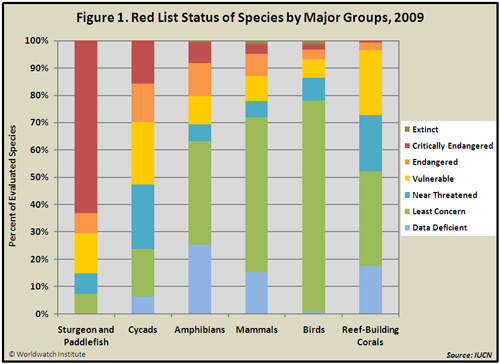World Will Completely Miss 2010 Biodiversity Target
John Mulrow | Apr 22, 2010
|
Species classified by the International Union for
Conservation of Nature (IUCN) as "threatened" increased by
2.1 percent in 2009, as 365 species were added to the
organization's Red List of Threatened Species. Only
2 species were removed from the list. Since 1996, a total of
47,677 species of animals, plants, fungi, and protists (a
group that includes protozoans and most algae) have been
evaluated by the IUCN, and 17,291 of these are now
considered threatened—a full 36 percent.
|
Species classified by the International Union for Conservation of Nature
(IUCN) as "threatened" increased by 2.1 percent in 2009, as 365 species
were added to the organization's Red List of Threatened Species.1 Only 2
species were removed from the list.2 Since 1996, a total of 47,677
species of animals, plants, fungi, and protists (a group that includes
protozoans and most algae) have been evaluated by the IUCN, and 17,291
of these are now considered threatened—a full 36 percent.3 (See Table
1.)
All species evaluated by IUCN are given a threat rating based on a
standardized set of data that includes population size and structure and
geographic range.4 Evaluated species for which data exist are divided
into seven groups: least concern, near threatened, vulnerable,
endangered, critically endangered, extinct in the wild, and extinct.
Species in the three middle categories—vulnerable, endangered, and
critically endangered—are collectively referred to as threatened.
Species for which data are not available are not included in the seven
groups, even if many of them are thought to be threatened.5
A complete evaluation of the world’s 1.7 million known species—not to
mention the 3–50 million species that have yet to be discovered—is
extremely far off, but some species families have been completely
described and evaluated, including birds, mammals, and amphibians.6
Below the family level, reef-forming corals, conifers, cycads (palm-like
plants), freshwater crabs, groupers, and most recently sturgeon have
also been evaluated.7 Currently, 30 percent of amphibians, 21 percent of
mammals, and 12 percent of bird species are listed as threatened with
extinction.8 Of all groups evaluated, cycads and sturgeon have the
highest proportion of threatened species, at 52 and 85 percent
respectively.9 (See Figure 1.)
For full access to the complete trend and its associated charts, log in to Vital Signs or: http://vitalsigns.worldwatch.org/cart/add/p105_q1?destination=cart
© 2008 | Worldwatch Institute To subscribe or visit go to: http://vitalsigns.worldwatch.or
